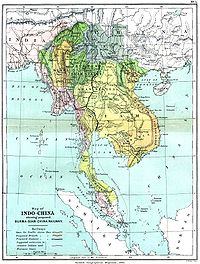Bombardment of Qui Nhơn
| Bombardment of Qui Nhơn | |
|---|---|
| Part of the Qui Nhơn, Vietnam | |
| Result |
American victory;
|
1 fort destroyed
The bombardment of Qui Nhơn in 1861 was an attack by a United States Navy warship upon a
Bombardment

USS Saginaw's crew was just putting the anchor down when the first shot burst in the water next to the ship. Surprised, the Americans first raised a white flag to show their friendly intentions but then a second shot was fired along with a third. Trying to get up steam, the Saginaw turned around and withdrew slowly to 900 yards, by which time her crew were at station and ready for action. The American gunners returned fire with one of their 32-pounders and after only about twenty minutes the Vietnamese guns were silenced. A secondary explosion was observed and it was suspected that either the powder magazine of the fort, or one of the guns, blew up and killed their operators. After the explosion no further shots were fired from the fort. However, the Saginaw's gunners continued their bombardment for another half-hour unopposed until the fort was in ruins. American forces suffered no damage or casualties and after the action, communicating with the Vietnamese proved fruitless so the Saginaw steamed back to Hong Kong.[3]
The men of Saginaw ultimately did not find the missing American sailors. Commander Schenck went on to serve with distinction at the battles for Fort Fisher during the American Civil War.[4][5][6]
See also
- Bombardment of San Juan del Norte
References
- ^ Schenck, pg. 90–91.
- ^ Schenck, pg. 90–91.
- ^ Schenck, pg. 90–91.
- ^ Schenck, pg. 90–91.
- ^ Michael Schroeder (October 13, 2011). "Apocalypse 1861". Geni.com. Retrieved January 26, 2019.
- ISBN 978-1-59884-530-3.
This article incorporates text from the public domain Dictionary of American Naval Fighting Ships.
- Schenck, Alexander (1883). The Rev. William Schenck, his ancestry and his descendants ... R.H. Darby Publishing.
